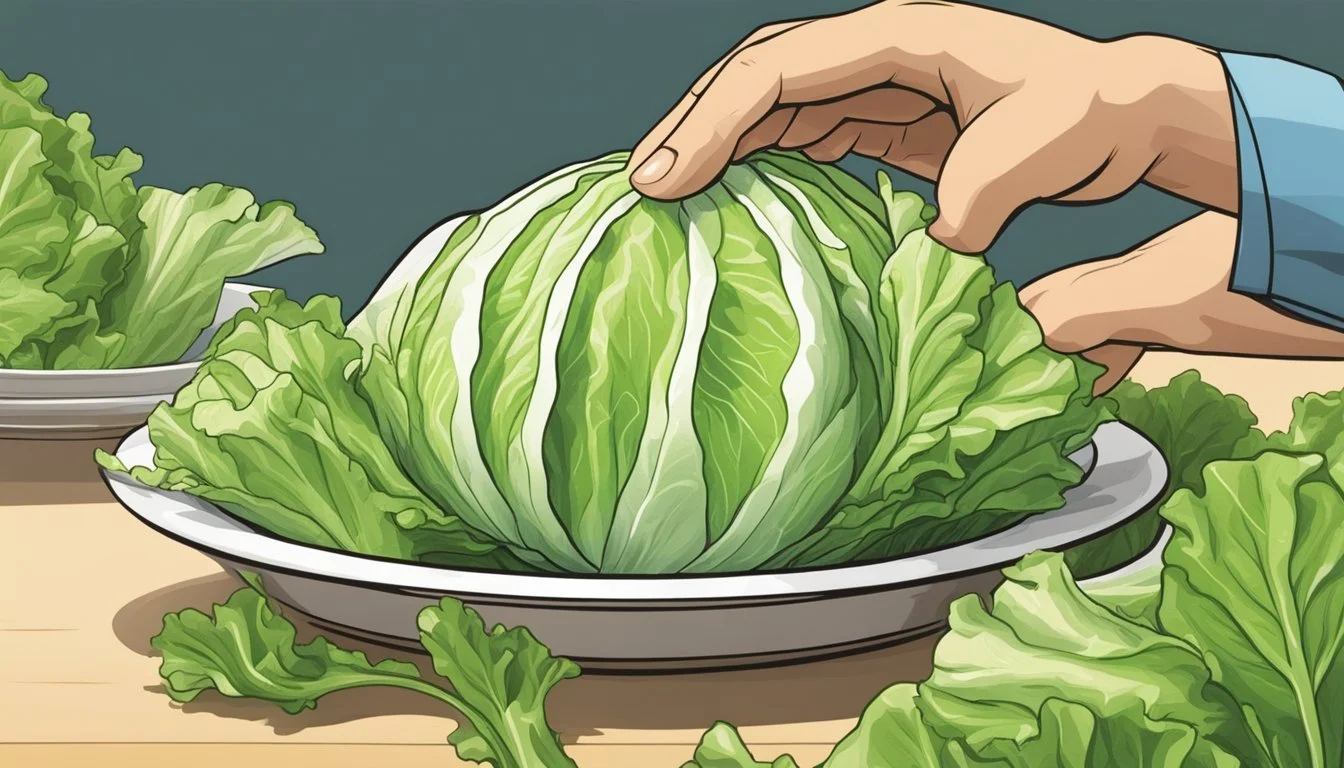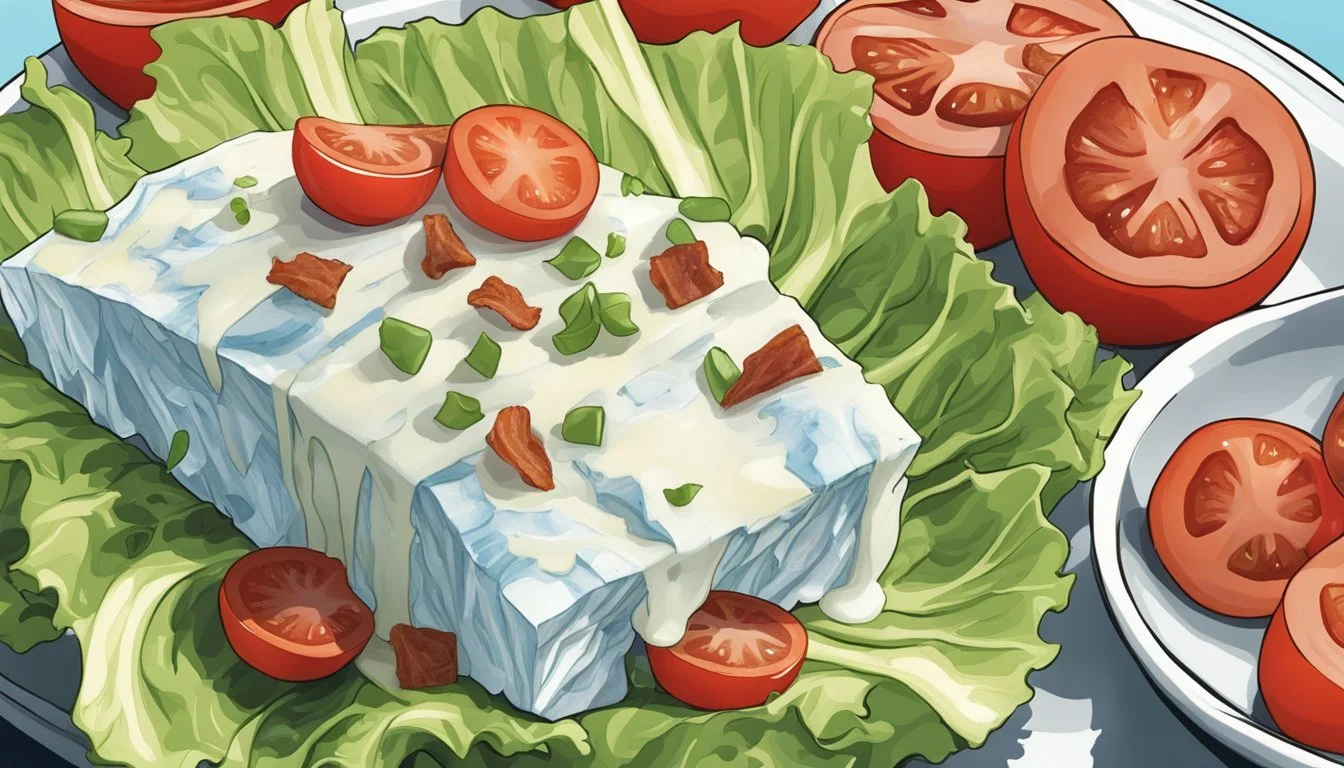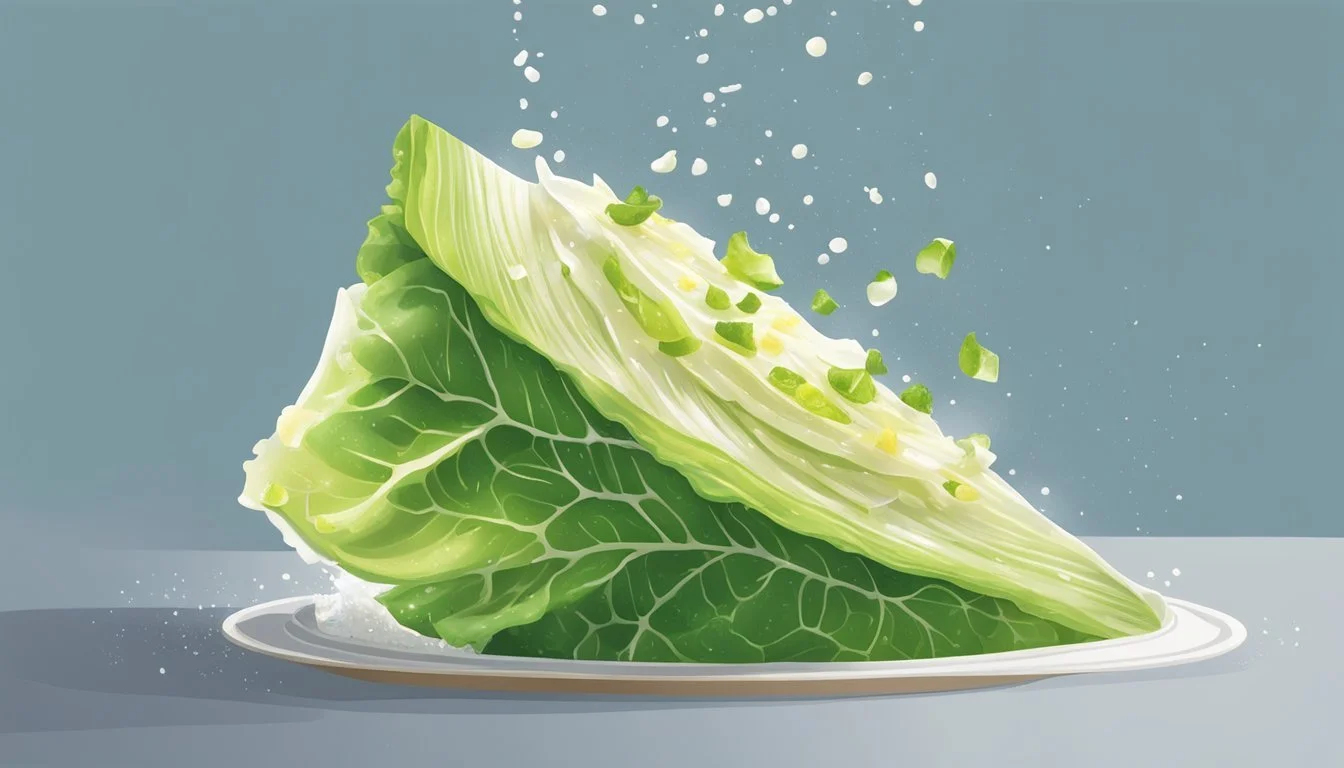How Do You Eat an Iceberg Lettuce Wedge?
Expert Tips for Enjoying This Crunchy Classic
Eating an iceberg lettuce wedge is straightforward and provides a refreshing, crunchy addition to any meal. This classic salad setup includes a crisp quarter of iceberg lettuce, often topped with a creamy dressing like blue cheese or ranch. The firm texture of iceberg lettuce allows the wedges to hold up well under a variety of toppings such as bacon (how long does bacon last?) pieces, diced tomatoes, chives (how long do chives last?), and crumbled cheese.
To consume an iceberg lettuce wedge, it’s typically placed on a plate with the dressing and toppings already added. Diners can use a knife and fork to cut bite-sized pieces, enjoying the combination of flavors and textures in each forkful. This method of eating ensures the lettuce remains intact and crisp until it's ready to be enjoyed, making the wedge salad not just a dish but a dining experience.
Iceberg lettuce holds a place in culinary tradition for its ability to stay fresh during transport, which led to its prominence in American cuisine. While often underestimated nutritionally, iceberg lettuce provides hydration and is a good source of fiber. It is the foundation of the wedge salad, showcasing how simple ingredients can create a satisfying and visually appealing dish.
Selecting and Preparing Iceberg Lettuce
When choosing iceberg lettuce, look for a head of lettuce that is fresh with crisp, springy leaves. It should have a bright appearance, free from dark or slimy spots. The leaves should be firm, not limp or withered, and devoid of any brown or yellow discoloration. The most nutritious and flavorful part is typically the dark green outer leaves, although these are also more susceptible to damage.
Preparing the lettuce involves a few simple steps. First, discard any wilted outer leaves to ensure only the best parts are used. Next, to remove the core, one should invert the head of lettuce and cut a circle around the base. A firm tap against a cutting board will loosen the core enough to pull it out.
Here is a brief guideline to cut the lettuce:
Lay lettuce on a cutting board.
Remove core and discard wilted leaves.
Cut the head into quarters.
Iceberg lettuce, when quartered, is ideal for a wedge salad. Before cutting into wedges, the lettuce should be rinsed under cold water to remove any residual dirt or debris. It's essential to drain the lettuce well or use a salad spinner to remove excess water to avoid a soggy salad. Once are cut and washed, they are ready to be dressed and served.
Cutting Lettuce Into Wedges
When preparing iceberg lettuce for a salad, transforming it into wedges requires a methodical approach to maintain the crispness and shape of the leaves while ensuring safety during cutting.
Expert Tips for Wedging Lettuce
Selecting the Lettuce:
Start with a fresh head of iceberg lettuce that is firm and free of blemishes.
Removing the Core:
Place the lettuce on its side. Using a sharp knife, slice about 1 inch from the bottom to remove the core.
Slicing into Wedges:
Stand the lettuce upright where the core was removed. Cut the head in half from top to bottom.
Lay each half flat and slice into additional halves or thirds, depending on desired wedge size. This usually results in four to six wedges.
Safety Considerations When Cutting
Knife Selection:
Use a sharp, long chef's knife which provides control and minimizes slippage.
Cutting Surface:
Secure the iceberg lettuce on a stable cutting board to prevent movement.
Hand Placement:
Keep fingers tucked in and use a claw grip to hold the lettuce while slicing.
Wash and Dry Lettuce Wedges
When preparing iceberg lettuce wedges, it is essential to ensure they are properly washed and dried for health and taste. The texture of the lettuce should remain crisp, so the process must be handled with care.
Steps for washing:
Remove Damaged Leaves: Starting with a fresh head of iceberg lettuce, one should discard any bruised or wilted outer leaves.
Rinse with Water: The entire head of iceberg lettuce should be placed under cool running water. This helps to loosen and remove any remaining dirt.
Shake Gently: After rinsing, the lettuce should be lightly shaken to shed excess water, taking care not to bruise the leaves.
Drying process:
Use a Clean Kitchen Towel: For optimal drying, one can pat the lettuce head dry with a clean towel.
Optional: Use Parchment Paper: Alternatively, after shaking off water, one could wrap the lettuce in parchment paper, which can absorb additional moisture, ensuring the leaves aren’t too wet when cut into wedges.
Cutting into wedges:
Halve the Lettuce: The cook should first slice the head of lettuce in half through the stem end.
Quarter the Halves: Each half is then to be cut into two wedges, creating four even sections. For larger heads, thirds may be more suitable.
The lettuce wedges are now clean, dry, and ready to be dressed or served according to the recipe's following steps. Properly washed and dried wedges will maintain their structure and offer the characteristic crunch that elevates the textures in a wedge salad.
Assembling the Wedge Salad
When constructing a wedge salad, precision in layering toppings and the harmonious pairing of salad dressing are essential for an impeccable taste experience.
Layering Toppings
A wedge salad recipe typically begins with a chilled quarter of iceberg lettuce that serves as a crisp base. To maintain the structural integrity of the salad, one should start with a drizzle of dressing to lightly coat the wedge. Following the dressing, one layers on a variety of toppings that typically include crumbled bacon, chopped hard-boiled eggs, and diced fresh tomatoes. For additional texture and flavor, crumbled blue cheese or shaved red onions can be interspersed among the layers.
Toppings Sequence:
Drizzle dressing
Add crumbled bacon
Place chopped eggs
Scatter diced tomatoes
Sprinkle blue cheese or red onions, if desired
This sequence of toppings not only ensures each bite is flavorful but also preserves the crispness of the lettuce base.
Choosing the Right Dressing
The dressing acts as the unifying agent in a wedge salad, bringing together the diverse flavors and textures. Blue cheese dressing, with its rich and tangy profile, is a traditional favorite for complementing the savory notes of bacon and the neutrality of iceberg lettuce. Alternatively, ranch dressing provides a creamy herbaceous coating that pairs well with the varied salad toppings. Whether opting for a homemade or store-bought dressing, it should be of suitable consistency to adhere to the lettuce without weighing down the toppings.
Dressing Options:
Blue cheese dressing: Offers a robust tang
Ranch dressing: Delivers a creamy herb flavor
In selecting the dressing, one should consider both personal taste preferences and the balance of flavors within the wedge salad recipe.
Classic Wedge Salad Toppings
A classic wedge salad shines with an array of toppings that enhance its flavors and textures. From the salty crispness of bacon to the fresh burst of ripe tomatoes, each element contributes to a balanced, satisfying dish.
Adding Crunch with Bacon and Croutons
The smoky flavor of bacon is essential in a wedge salad, providing a satisfying crunch. Bacon crumbles work well as a topping, offering a textural contrast against the crisp lettuce. For additional crunch, one can also incorporate croutons, which add not only texture but also a seasoned bite to the salad.
Bacon: Cooked until crisp, then crumbled
Croutons: Ideally seasoned and toasted for extra crunch
Incorporating Fresh Vegetables
Fresh vegetables add both color and flavor to the wedge salad. Tomatoes are a classic choice, often used as diced tomato or cherry tomatoes. They introduce a juicy sweetness that pairs well with the rich dressing. Cucumbers offer a cool, refreshing crispness, while avocado lends a creamy texture that enriches the dish. Pieces of olives or a sprinkle of nuts can be used for an additional savory touch.
Tomatoes: Diced or sliced, including cherry tomatoes
Cucumber: Thinly sliced or chopped
Avocado: Pitted, peeled, and diced
Olives: Sliced or chopped, depending on preference
Selecting Cheeses for Flavor
Blue cheese is a traditional choice for wedge salads, known for its strong and distinctive flavor. It can be served as crumbles or as part of a blue cheese dressing. Fresh herbs (how long do fresh herbs last?) like chives, specifically fresh chives, bring brightness to the cheese, enhancing its flavor with their light onion-like taste. A sprinkle of black pepper can be used to season the cheese further for an extra depth of flavor.
Blue Cheese: Crumbled or whisked into dressing
Chives: Fresh and finely chopped
Black Pepper: Freshly ground, to taste
Dressing the Wedge
The quintessential step in preparing an iceberg lettuce wedge salad is the application of the dressing. This should be approached with a view to complement the crisp, cool qualities of the lettuce with a burst of flavor. Ranch dressing and blue cheese dressing are the two popular choices for drizzling over the wedge, providing a creamy texture and a tangy taste.
Ranch dressing typically consists of a blend of mayonnaise, sour cream, or buttermilk, seasoned with garlic, lemon juice, and various herbs to achieve its distinctive flavor. For those who prefer a homemade touch, combining these ingredients in equal parts can yield a fresh and flavorful ranch.
Alternatively, blue cheese dressing embraces the strong notes of blue cheese, often mixed with the same creamy bases—mayonnaise and sour cream—to balance the intensity. The tanginess of blue cheese provides a robust counterpoint to the crispness of the lettuce.
For a lighter dressing option, a vinaigrette can offer a zestful and less creamy topping. It is generally made with a simple mixture of oil, vinegar, and seasonings, delivering a sharp flavor that can enhance the fresh, natural taste of iceberg lettuce.
A properly dressed wedge salad should have the dressing evenly distributed to ensure every bite includes the creamy or zesty complement to the lettuce. It's advisable to serve the dressing on the side or lightly drizzled over the top to maintain the lettuce's crunch.
Recommended Dressing Amount: About 2-3 tablespoons per wedge
Serving Suggestion: Offer extra on the side
Remember, the goal is to achieve a balance that allows the quality of the fresh lettuce to shine through, enhanced by the chosen dressing.
Seasoning Your Wedge Salad
When crafting the perfect wedge salad, seasoning is crucial for enhancing the flavors. The right combination and application of seasonings bring out the fresh, crisp taste of the iceberg lettuce and complement the toppings.
Start by lightly sprinkling salt over the wedge to accentuate the natural flavors of the lettuce. A pinch of salt can highlight the subtle taste, but it should be used sparingly to avoid overpowering the dish.
Black pepper adds a gentle heat and depth. Freshly cracked black pepper works best, offering a more robust flavor than pre-ground varieties. One should season with pepper to personal taste, as it can significantly influence the salad's overall spiciness.
For those who enjoy a more pronounced pepper flavor, adding crushed red pepper flakes can introduce a warm, piquant element that pairs particularly well with creamy dressings and rich toppings like bacon and blue cheese.
Incorporating fresh herbs like chives or parsley can offer a burst of freshness. Chives bring a mild onion-like taste that doesn't overshadow the other ingredients, while parsley provides a clean and slightly peppery note. These herbs should be finely chopped and sprinkled over the salad just before serving to maintain their vibrant flavor and color.
Here's a simple guide to the application of these seasonings:
Seasoning Suggested Application Salt Light sprinkle, to taste Black Pepper Freshly ground, to taste Pepper Optional, adjust for heat preference Chives Finely chopped, as garnish Parsley Finely chopped, as garnish
It is important to season the wedge salad just before serving to ensure that the lettuce remains crisp and that the flavors are at their peak when enjoyed.
Serving the Wedge Salad
A wedge salad, characterized by its crisp iceberg lettuce base, is traditionally served as a refreshing starter or side dish. It is a versatile accompaniment to an assortment of main dishes and is appreciated for its textural contrast and cool taste.
Plating Individual Portions
When serving wedge salad, one must first ensure that each piece of iceberg lettuce is cut into a sizable wedge, often quartered from the whole head. Each wedge is then placed onto a plate as a standalone salad portion. It's imperative to gently rinse and pat the wedges dry before plating, maintaining the lettuce's crispness. The salad is typically drizzled with a choice of creamy dressing, and the toppings - which can vary from crispy bacon bits to diced tomatoes and blue cheese crumbles - are generously sprinkled atop the wedge.
Pairing with Main Dishes
The wedge salad's cool and crunchy profile makes it an ideal side for hearty and warm main dishes. Here are some classic pairings:
Steak: The richness of a perfectly grilled steak is balanced by the lightness of the wedge salad.
Grilled Chicken: A leaner option like grilled chicken complements the crispness of the salad without overpowering its subtle flavors.
Burgers: The classic American burger pairs well with the simplicity of the wedge salad, cutting through the density of the meal.
The careful selection of these pairings aims to create a harmonious dining experience, with the wedge salad enhancing the enjoyment of the main meal.
Nutritional Information and Diets
When considering the nutritional profile of iceberg lettuce, particularly the wedge salad, it is noteworthy for its low calorie count and the presence of certain vitamins and minerals. The lettuce is associated with diets that require low-calorie foods with high water content.
Calorie Count and Macronutrients
Iceberg lettuce is renowned for its low calorie content. A single cup of shredded iceberg lettuce typically contains about 10 calories. In terms of macronutrients, the same serving offers approximately:
0.5 grams of protein
<0.5 grams of fat (negligible amounts of polyunsaturated fat)
1.7 grams of carbohydrates
0.7 to 2 grams of fiber, depending on the source
For comparison, romaine lettuce, another popular salad green, has slightly higher calories and more fiber per serving than iceberg lettuce. It also contains more nutrients like iron, potassium, and vitamin A.
Adapting for Special Diets
People with specific dietary requirements can easily include iceberg lettuce in their meal plans. For those on low-calorie, low-carbohydrate, or low-fat diets, iceberg lettuce is an excellent choice because of its nutritional composition.
For ketogenic diets: Iceberg lettuce's low carb content suits the keto guidelines.
For vegetarian and vegan diets: It's a plant-based ingredient that provides fiber and micronutrients.
For gluten-free diets: Iceberg lettuce is inherently gluten-free, making it safe for individuals with celiac disease or gluten sensitivity.
It's important for individuals with diabetes to note the carbohydrate content, although it is minimal and primarily from fiber, which has a lesser impact on blood sugar levels. Those looking for more iron or folate in their greens might opt for romaine lettuce as an alternative.
Alternative Wedge Salad Variations
Exploring different variations can transform the classic wedge salad into a dish that caters to a wide range of tastes. Cheese selections and innovative garnishes can elevate the flavor and add depth to this simple yet satisfying salad.
Cheese Variations
Feta: A Greek salad spin can involve crumbling feta over the wedges, introducing a tangy and salty flavor that pairs well with olives and tomatoes.
Goat Cheese: Soft and creamy goat cheese offers a milder taste and can be sprinkled on as crumbles or in dollops.
Gorgonzola: For a more pungent kick, gorgonzola, a type of blue cheese, can be used to add a bold, savory flavor.
Parmesan: Shavings of parmesan give a nutty and salty dimension that complements the crispness of the lettuce.
Mozzarella: Fresh mozzarella, especially when paired with ripe cherry tomatoes and basil, brings a classic Caprese twist to the dish.
Garnishes and Additives
Bell Peppers: Slices or diced bell peppers can introduce a sweet or slightly bitter note depending on the color used.
Radishes: Thinly sliced radishes offer a peppery crunch that contrasts the soft lettuce leaves.
Eggs: Chopped hard-boiled eggs add protein and richness, with the yolk bringing creaminess that can bind the toppings to the lettuce.
Beets: Roasted or pickled beets contribute an earthy sweetness and vibrant color, making the salad both visually appealing and flavorful.
The choice of cheese and the combination of garnishes can significantly alter the taste of the wedge salad, providing endless possibilities for customization and enjoyment.
Preparing Wedge Salads for a Crowd
When hosting a large gathering, presenting a wedge salad can be an elegant and practical choice. The crispness of iceberg lettuce serves as a refreshing base for a variety of toppings. To efficiently prepare wedge salads for a crowd, they must approach the preparation methodically.
Ingredient Quantities
The initial step is to ensure there is enough iceberg lettuce for the number of guests. One head of lettuce typically yields four wedges, so they should plan on half a head per guest.
Cleaning the Lettuce
They must thoroughly wash the lettuce while keeping it intact. It's recommended to remove the outermost leaves and rinse the whole head under cold water. Then, they can gently tap the head to remove excess water.
Cutting the Wedge
With the lettuce clean, it’s time to cut it into wedges. Placing the head of lettuce stem-side down, they should slice it into quarters for ample-sized portions using a sharp knife.
Chilling the Wedges
For optimal crispness, they should chill the wedges in the refrigerator before serving.
Salad Plates
For presentation, using individual salad plates adds to the visual appeal and makes it easier for guests to enjoy their meal. They can distribute one wedge per plate.
Dressing and Toppings
A variety of dressings and toppings should be available on the side. This allows guests to customize their wedge salad to their taste preferences.
By following these steps, they can serve a classic and refreshing wedge salad with efficiency and flair, perfect for satisfying a crowd.
Homemade Dressings and Additions
When enjoying an iceberg lettuce wedge, the choice of dressing can elevate the dish from simple to spectacular. Homemade dressings not only allow for customization but also tend to be fresher and devoid of preservatives found in store-bought versions.
A classic blue cheese dressing is a popular choice for wedge salads. One can employ a food processor to blend blue cheese, sour cream, mayonnaise, garlic, and a squeeze of lemon juice, creating a rich and tangy dressing.
Ranch dressing is another fitting option, blending buttermilk, mayo, fresh herbs like dill and parsley, garlic, and onion powder in compliance with one's palate. Its creamy texture and herbaceous flavor harmonize with the crispness of iceberg lettuce.
For those who favor a slightly lighter dressing, a Caesar dressing works exceptionally well. It generally consists of anchovies, (What wine goes well with anchovies?) garlic, Parmesan cheese, and lemon juice emulsified with olive oil, presenting a balance of umami and acidity.
Ingredients Potential Dressing Blue cheese Blue Cheese Dressing Buttermilk Ranch Dressing Anchovies Caesar Dressing
Additional toppings can include crisp cooked bacon, diced hard-boiled eggs, or a sprinkle of fresh chives to contribute texture and layers of flavor. When constructing the salad, the dressing should be drizzled generously over each lettuce wedge, allowing the flavors to infiltrate the leaves, while the toppings bring a satisfying crunch to each bite.
Dressings can be made ahead of time and refrigerated, ensuring that the flavors meld and the salad can be assembled swiftly and served chilled, preserving its refreshing quality.
Storage and Leftovers
Proper storage of iceberg lettuce ensures both the freshness of leftovers and the edibility of the vegetable over time. This section highlights how to refrigerate leftover ingredients to maximize their shelf life and provides tips for reviving wilted lettuce to ensure that it can be enjoyed to its fullest.
Refrigerating Leftover Ingredients
To maintain the quality of leftover iceberg lettuce wedges and other ingredients, one should store them in the refrigerator promptly. Leftover heads of lettuce should be wrapped in a dry paper towel and placed in a plastic bag with some air holes for circulation. This method helps in absorbing excess moisture while keeping the lettuce crisp. The ideal temperature for storing lettuce is between 32°F and 40°F. Ensure that any additional salad components, like dressing or toppings, are stored separately to prevent the lettuce from becoming soggy.
Reviving Wilted Lettuce
Even with optimal storage, lettuce leaves may sometimes wilt. To revive them, one can soak the wilted lettuce in ice water for about 15 minutes. The cold water helps rehydrate the leaves and restore their crispness. After soaking, thoroughly drain and pat dry the leaves before serving or re-storing them in the refrigerator. If the lettuce is too wilted and cannot be revived, it is best used in cooked dishes, such as stir-fries or soups, where the texture is less critical.
Frequently Asked Questions
This section delves into key queries regarding the preparation and nutritional aspects of iceberg lettuce, providing confident and clear answers to enhance your dining experience.
Common Preparation Inquiries
When approaching the preparation of iceberg lettuce wedges, one initially opts for a technique that ensures the wedge stays intact.
How does one cut iceberg lettuce into wedges?
It's preferable to place the lettuce core down on a cutting surface. Then, slice the lettuce in half, followed by cutting each half again into halves or thirds, depending on the lettuce size. It is essential to leave the core attached, which acts to hold the wedge together.
What is the correct method for washing iceberg lettuce wedges?
Gently rinse each wedge under cold water, making certain to reach between the leaves to eliminate any hidden dirt. Then, thoroughly dry the wedges, as excess water can dilute the dressing.
Addressing Health Concerns
Consumers often inquire regarding the health implications involved with consuming iceberg lettuce.
Is iceberg lettuce nutritionally beneficial?
While iceberg lettuce is lower in nutrients compared to darker leafy greens, it still provides hydration due to its high water content and contains a small amount of vitamins A and C.
By adhering to these guidelines, one ensures the iceberg lettuce's crispness and freshness are retained, leading to a more enjoyable salad experience.
Conclusion
Eating an iceberg lettuce wedge is straightforward and offers a refreshing, crunchy experience. It typically involves the following steps:
Preparing the Wedge: One starts by cutting a head of iceberg lettuce into quarters or sixths, depending on the preferred size of the wedge.
Dressing Application: A generous drizzle of dressing, which varies according to the salad recipe, is applied over the wedge. Choices may include blue cheese, ranch, or a creamy feta dressing, among others.
Adding Toppings: Garnishes such as bacon crumbles, diced tomatoes, thinly sliced red onions, crumbled blue cheese, and chives add layers of flavor and texture.
Serving: The dressed wedge is usually served cold on individual plates, ready for consumption.
When consuming a lettuce wedge, it is common to use both a fork and knife. The diner can cut bite-sized pieces off the wedge, ensuring each piece carries a portion of the toppings and dressing. This technique allows for a harmonious blend of flavors with each forkful.
Lastly, it's important to remember that while iceberg lettuce is often characterized as less nutrient-dense compared to darker leafy greens, it still provides hydration and fiber. Therefore, a well-prepared iceberg lettuce wedge salad is not only delightful to eat but also a cool and crisp addition to any meal.
















